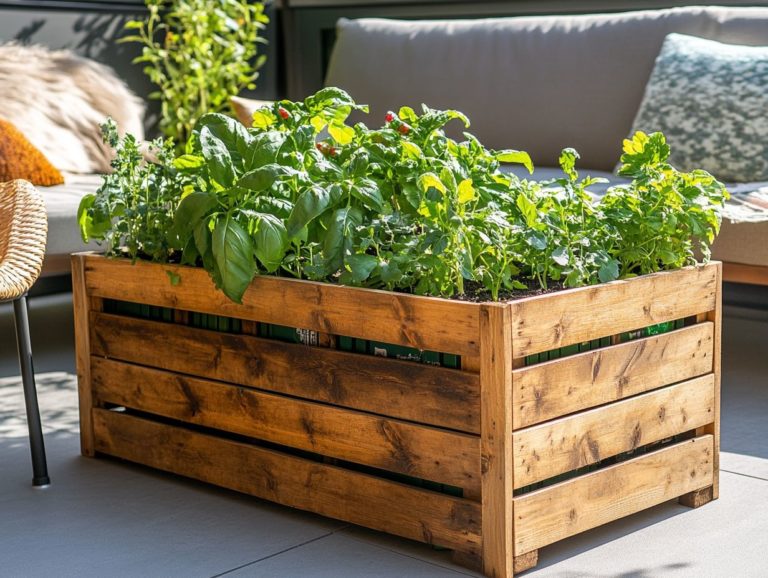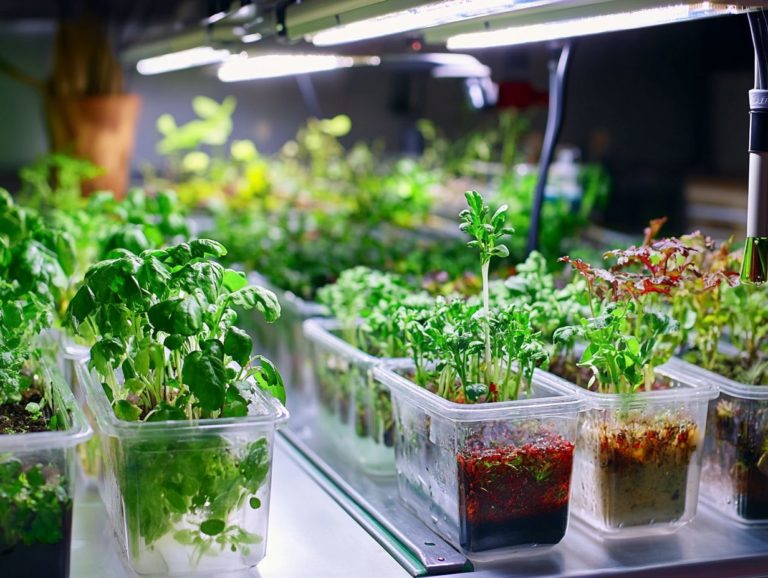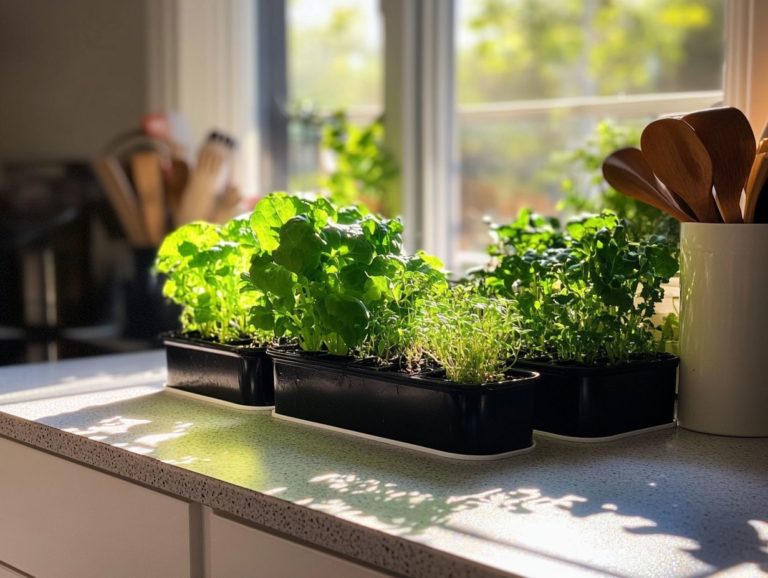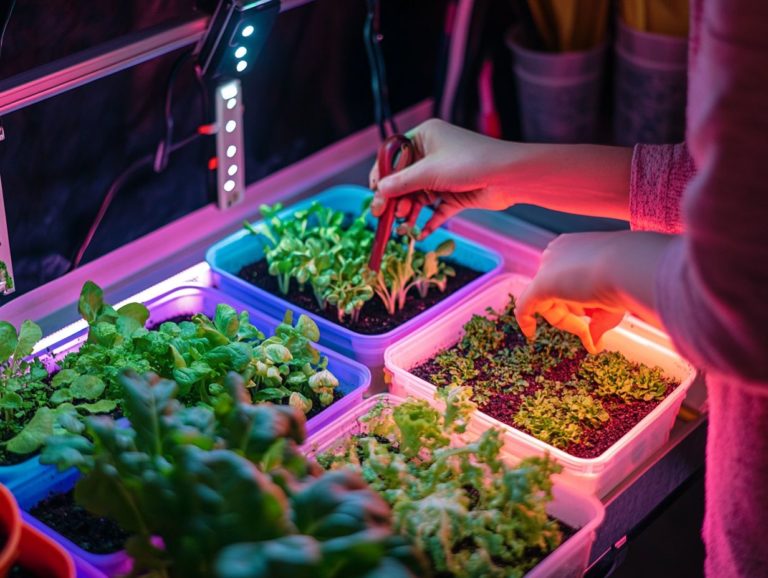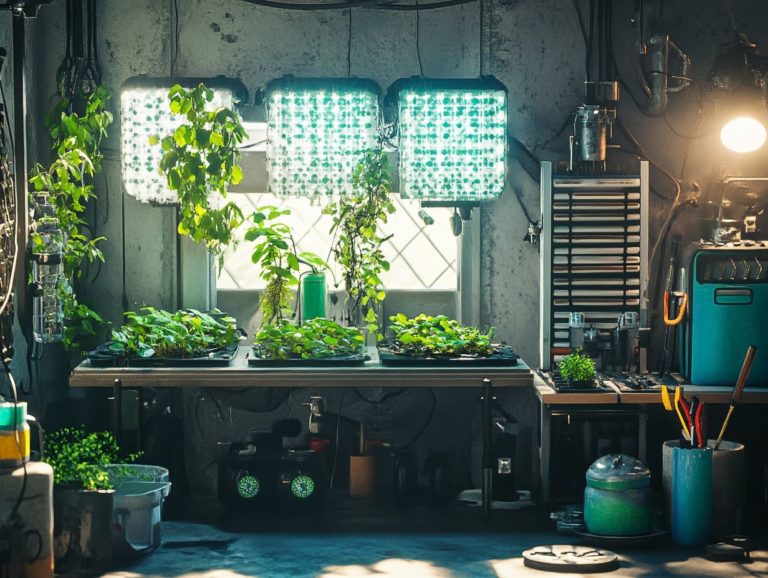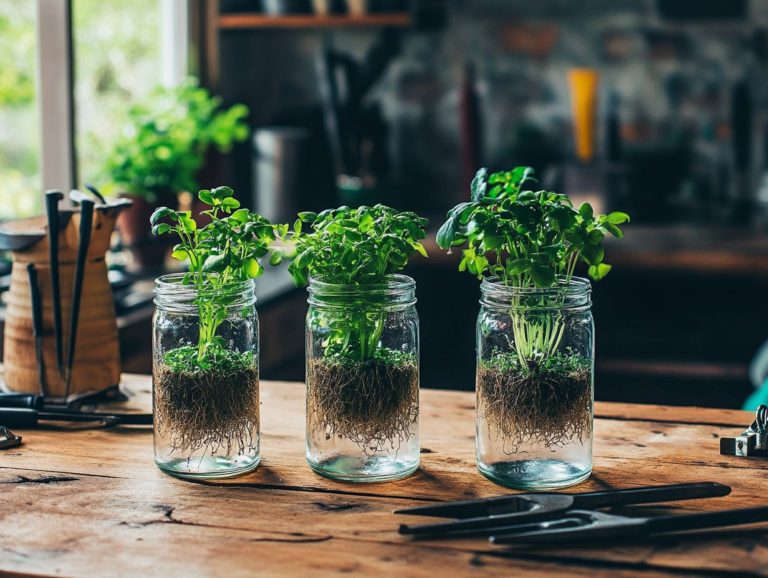The Future of DIY Hydroponic Gardening
Hydroponic gardening is revolutionizing how you approach food cultivation, providing a soilless alternative that optimizes both space and resources.
This exploration delves into the myriad benefits of DIY hydroponic gardening, emphasizing its advantages over traditional methods and its positive impact on the environment.
You ll discover comprehensive guidance on setting up your own hydroponic system, complete with straightforward instructions and maintenance tips to ensure your plants flourish. You will also learn about the exciting future of hydroponic gardening!
Contents
- Key Takeaways:
- What is Hydroponic Gardening?
- Benefits of DIY Hydroponic Gardening
- How to Set Up a DIY Hydroponic Garden
- Tips for Maintaining a Successful Hydroponic Garden
- The Future of DIY Hydroponic Gardening
- Frequently Asked Questions
- What is the future of DIY hydroponic gardening?
- What are the benefits of DIY hydroponic gardening?
- Is DIY hydroponic gardening suitable for all types of plants?
- Are there any downsides to DIY hydroponic gardening?
- Can hydroponic gardening help with food sustainability?
- How can I get started with DIY hydroponic gardening?
Key Takeaways:
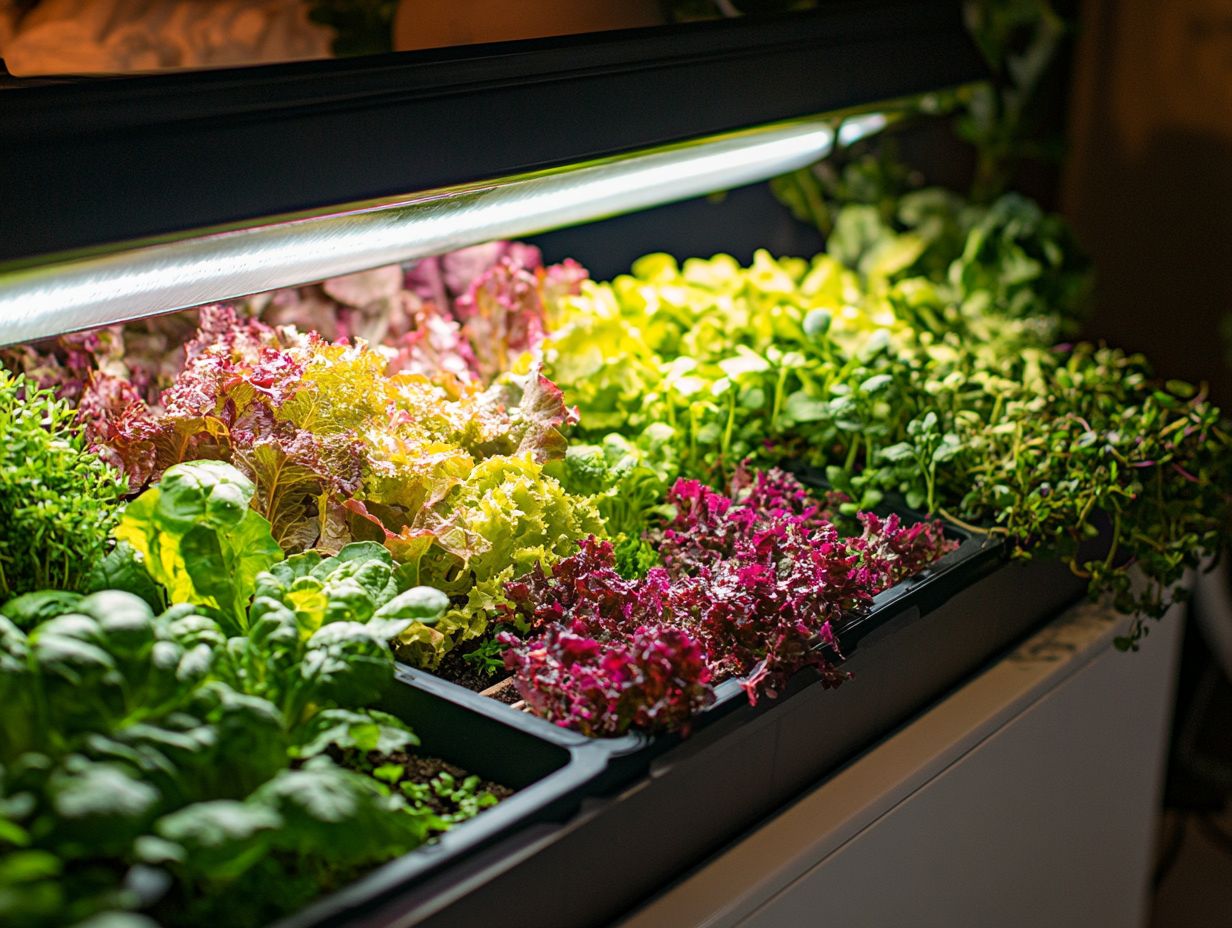
- DIY hydroponic gardening offers numerous benefits over traditional gardening, including higher yields, year-round growth, and reduced water usage.
- As advancements and innovations continue to emerge, the future of DIY hydroponic gardening looks promising for improving agricultural practices and promoting sustainability.
- Proper maintenance, including monitoring nutrient and pH levels and implementing pest control measures, is crucial for the success of a DIY hydroponic garden.
What is Hydroponic Gardening?
Hydroponic gardening is a game-changer for growing plants without soil, using nutrient-rich water solutions to deliver essential elements for optimal growth. This innovative method has become a favorite among urban farmers and DIY enthusiasts who are passionate about sustainable living.
Not only does it provide a resource-efficient alternative to traditional gardening, but it also aligns beautifully with eco-friendly practices and agricultural advancements in the face of climate change.
Within the realm of hydroponic gardening, various systems showcase its remarkable adaptability and efficiency. For example, the Nutrient Film Technique (NFT) uses a thin film of nutrient solution flowing over the roots, while Deep Water Culture (DWC) suspends the plants in a nutrient-rich solution, allowing the roots to absorb precisely what they need.
These methods enhance growth rates, minimize water usage, and dramatically boost crop yields compared to conventional soil-based gardening. With precise control over nutrient solutions, you can ensure that your plants receive exactly what they need, fostering healthier crops in a shorter time frame.
Benefits of DIY Hydroponic Gardening
Engaging in DIY hydroponic gardening offers a wealth of benefits tailored to meet your individual needs while also addressing broader environmental objectives. This approach is particularly well-suited for families eager to immerse themselves in educational activities that champion sustainable living practices.
Whether you re cultivating fresh produce in a spacious backyard greenhouse or maximizing limited space with innovative hydroponic systems, you ll discover advantages that include enhanced crop yields, significant water conservation, and a reduced environmental footprint.
Advantages over Traditional Gardening
Hydroponic gardening presents a wealth of advantages over traditional gardening methods, especially when it comes to resource efficiency, crop yield, and the ability to control environmental factors like weather and pests. By eliminating the need for soil, hydroponic systems allow you to manage nutrient solutions and water use with precision, resulting in faster plant growth and higher quality food production.
Urban farmers are increasingly embracing hydroponics, thanks to its space-saving capabilities that enable vertical gardening techniques, maximizing the potential of limited urban real estate. You’ll be amazed to find that this method can save up to 90% more water compared to conventional gardening, while also reducing reliance on harmful pesticides, yielding healthier produce.
The compact design of hydroponic setups allows for year-round cultivation, making it an ideal choice for those living in metropolitan areas who seek sustainability and fresh food options. With all these compelling benefits, it s no wonder that hydroponics is capturing the interest of both amateur and professional gardeners alike.
Start your hydroponic garden today and experience the future of sustainable food cultivation!
Environmental Benefits
The environmental benefits of hydroponic gardening are truly remarkable, especially when you consider sustainable living and the pressing challenges posed by climate change. Hydroponics significantly reduces water consumption. It uses a closed-loop system that minimizes waste and fosters eco-friendly practices.
This method allows for year-round food production, regardless of changing weather. Imagine using up to 90% less water compared to traditional soil-based agriculture, all while eliminating runoff that can lead to soil and water pollution.
Hydroponics opens the door to cultivating crops in urban areas, effectively reducing the carbon footprint associated with transporting food over long distances. By incorporating sustainable practices like LED grow lights for energy efficiency and using organic nutrients, you can see how hydroponics aligns seamlessly with eco-conscious principles.
These innovative systems embody a holistic approach to agriculture, revealing how modern techniques can promote both environmental stewardship and food security.
How to Set Up a DIY Hydroponic Garden
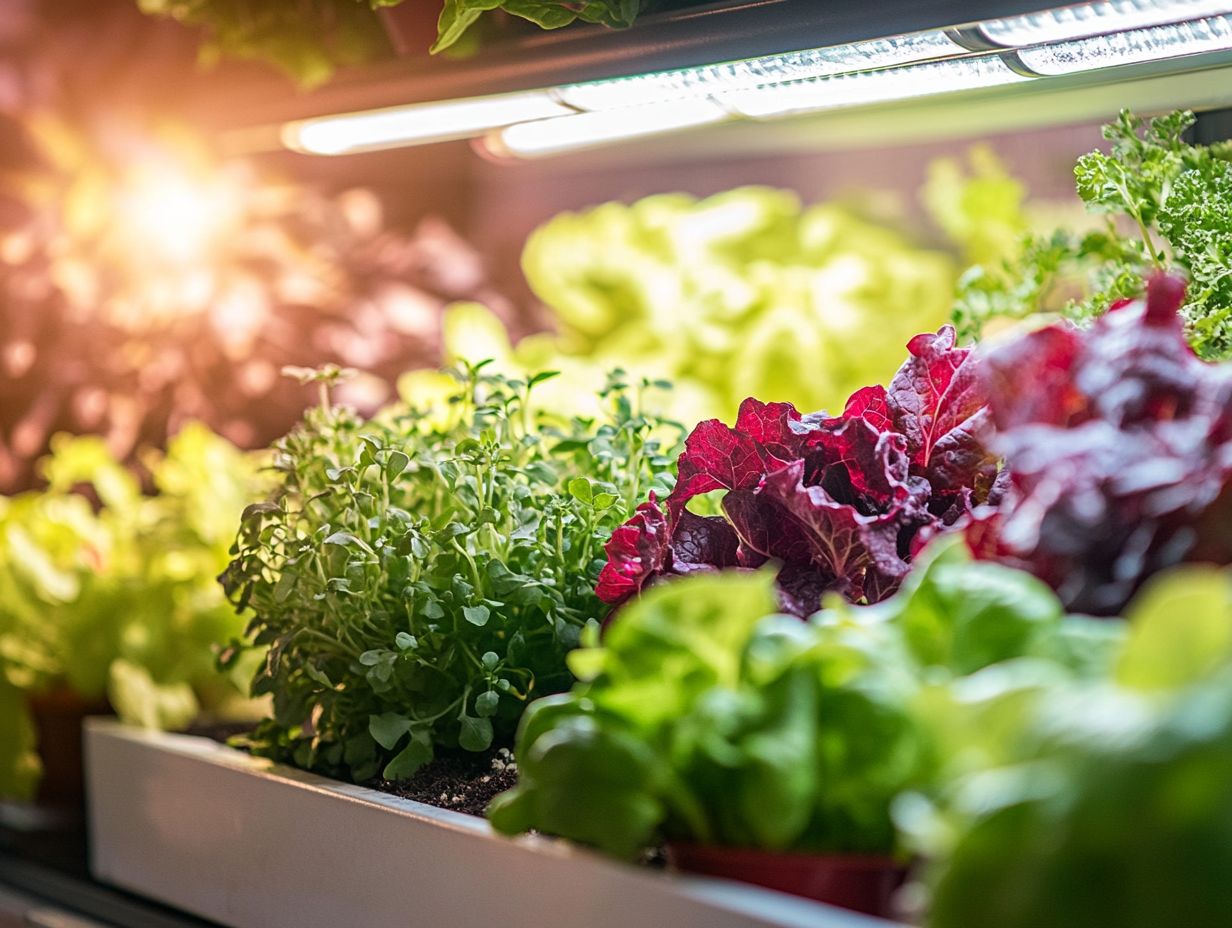
Ready to dive into the world of DIY hydroponic gardening? It s an exciting way to grow your own food! Setting up a DIY hydroponic garden is a rewarding journey that elevates your self-sufficiency and gives you the power to cultivate nutrient-rich food right in your own home or backyard greenhouse.
With thoughtful selection of hydroponic equipment and a well-structured approach, you can create a flourishing hydroponic system that harnesses the power of grow lights for optimal plant growth. Dive into this project and watch your green thumb thrive.
Materials and Equipment Needed
To successfully establish your DIY hydroponic garden, you ll require a range of materials and equipment that nourish your plants, including:
- Hydroponic gear
- Nutrient solutions
- Effective grow lights
Each component is essential, ensuring your plants receive the nutrients and light they need for optimal growth.
Containers are fundamental for holding your plants and their growing medium; selecting the right size will promote healthy root development. Nutrient reservoirs are equally critical, as they store the water mixed with essential nutrients your plants need throughout their life cycle. Pumps will circulate this nutrient-rich solution, making sure each plant enjoys adequate hydration without the risk of stagnation.
Grow lights play the role of the sun, simulating its rays to provide the energy necessary for photosynthesis, which is the process plants use to turn sunlight into food. In indoor settings where natural light might fall short, these lights become vital. When you combine these elements, you create a balanced environment where your plants can truly thrive.
Step-by-Step Instructions
Setting up your DIY hydroponic garden is a straightforward journey that leads to optimal plant growth and a rewarding gardening experience. By following these step-by-step instructions, you can craft a hydroponic system that perfectly suits your unique needs and space constraints.
Before you plunge in, take a moment to gather all the essentials: containers for your plants, a nutrient-rich solution, and a dependable water source. Familiarizing yourself with the various types of hydroponic systems, like Nutrient Film Technique (NFT) or Deep Water Culture (DWC), will empower you to choose the best fit for your situation. For those looking to get started, exploring the top 10 DIY hydroponic projects for beginners can provide valuable inspiration.
As you prepare your workspace, ensure you have adequate lighting whether it s the sun s rays or some well-placed artificial lights to promote healthy growth. By following these initial steps, you’ll be well on your way to cultivating a hydroponic garden that not only dazzles the eye but also delivers fresh produce right at your fingertips.
Tips for Maintaining a Successful Hydroponic Garden
Maintaining a successful hydroponic garden demands your unwavering attention to detail, especially when it comes to nutrient balance, plant growth, and pest control. These elements are crucial for achieving high crop yields and ensuring sustainability.
By implementing effective maintenance practices, you can cultivate a flourishing ecosystem that thrives throughout the year. Don’t wait to start your sustainable garden. Begin today for fresh, homegrown produce!
Proper Nutrient and pH Levels
Achieving the right nutrient and pH levels is essential for your hydroponic garden’s success. These factors directly impact plant health and growth rates. Regularly monitoring and adjusting your nutrient balance ensures your plants receive the vital elements needed for optimal development.
Maintaining these levels is crucial; even minor fluctuations can lead to nutrient deficiencies or toxicities. To effectively monitor these parameters, invest in reliable tools such as pH meters and EC (electrical conductivity) meters, which provide real-time data on nutrient levels.
For most plants, a pH range of 5.5 to 6.5 is ideal. Nutrient solution concentrations can vary based on the crop. For example, lettuce thrives at an EC of 1.2 to 1.8. By consistently checking these levels, you help ensure your plants remain healthy and yield abundantly.
Pest and Disease Control
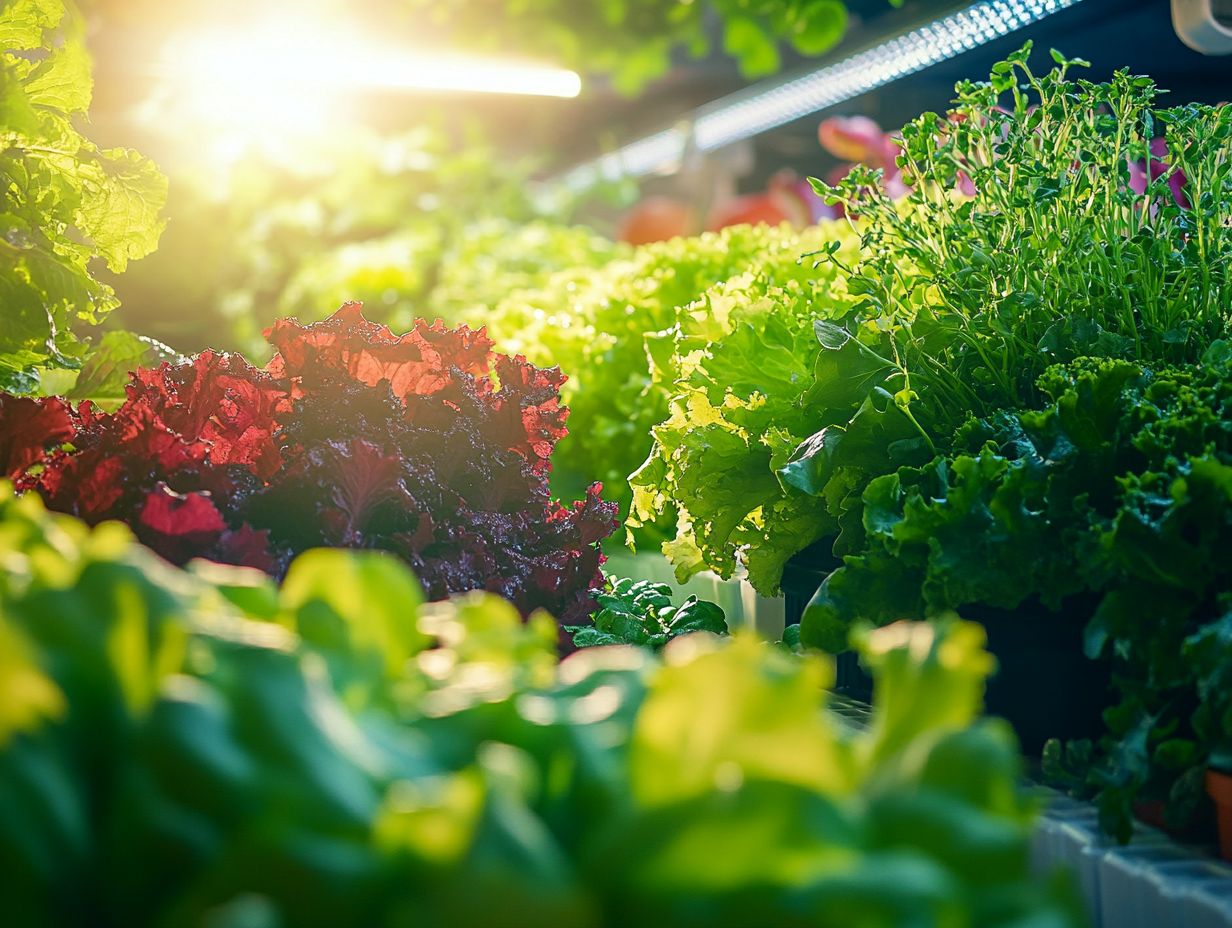
Effective pest and disease control is crucial for maintaining a thriving hydroponic garden. Pests can quickly undermine plant growth and crop yield. By using integrated pest management strategies, you can minimize the risk of infestations and ensure a fruitful growing season. This approach combines biological, cultural, and chemical methods, all tailored for hydroponic environments.
Utilizing companion planting helps deter pests naturally. Introducing beneficial insects, such as ladybugs, provides an effective biological control method.
Regular monitoring is key. Inspect your plants frequently for early signs of disease or infestation, enabling prompt action when necessary. Implementing sterile practices and using UV light systems can significantly reduce the chances of disease outbreaks.
When necessary, use chemical options like insecticidal soaps or neem oil sparingly to manage severe threats without harming your hydroponic ecosystem.
The Future of DIY Hydroponic Gardening
Get ready! The future of DIY hydroponic gardening is bright and full of opportunities. Advancements in hydroponic technology and agricultural innovation significantly enhance both feasibility and accessibility.
With a growing awareness of sustainable living practices, more individuals are embracing hydroponics as a practical way to cultivate food in diverse environments, from bustling urban areas to remote locations. This shift highlights the future of hydroponic growing systems as a viable solution for modern agriculture.
Advancements and Innovations
Recent advancements in hydroponic technology are transforming your approach to food production. This makes it more efficient and accessible for urban farming initiatives. These developments streamline growth processes and address the resource challenges often faced in traditional agriculture.
Automated nutrient delivery systems are particularly noteworthy. They ensure your plants receive the precise amount of nutrients they need, minimizing waste.
Energy-efficient grow lights allow you to cultivate crops indoors while keeping energy consumption low, significantly reducing your operating costs.
Smart monitoring tools provide real-time data on plant health and environmental conditions. This means you can make timely interventions as needed.
Collectively, these advancements enhance your crop yields and quality while fostering sustainable practices. They position urban agriculture as a viable solution for food security in densely populated areas.
Potential Impact on Agriculture and Sustainability
The potential impact of DIY hydroponic gardening on agriculture and sustainability is truly remarkable, as it presents solutions to the pressing challenges posed by climate change and food security.
By transitioning food production into controlled environments, you can significantly reduce resource consumption while championing sustainable practices.
This method reduces water usage and land degradation.
It empowers you and your community to take an active role in food production, nurturing a deeper connection to your environment.
Imagine transforming rooftops and small spaces into flourishing green areas; this innovative approach could revolutionize urban agriculture. By eliminating the need for harmful pesticides, hydroponics aligns seamlessly with eco-friendly initiatives that advocate for healthier ecosystems. To learn more about how this method is evolving, check out future trends in hydroponics.
Growing food locally through hydroponics allows you to effectively lower the carbon footprint linked to food transportation. This is a significant step toward building a resilient agricultural system that prioritizes sustainability and food security for generations to come.
Frequently Asked Questions
In this section, we will address common questions about DIY hydroponic gardening.
What is the future of DIY hydroponic gardening?
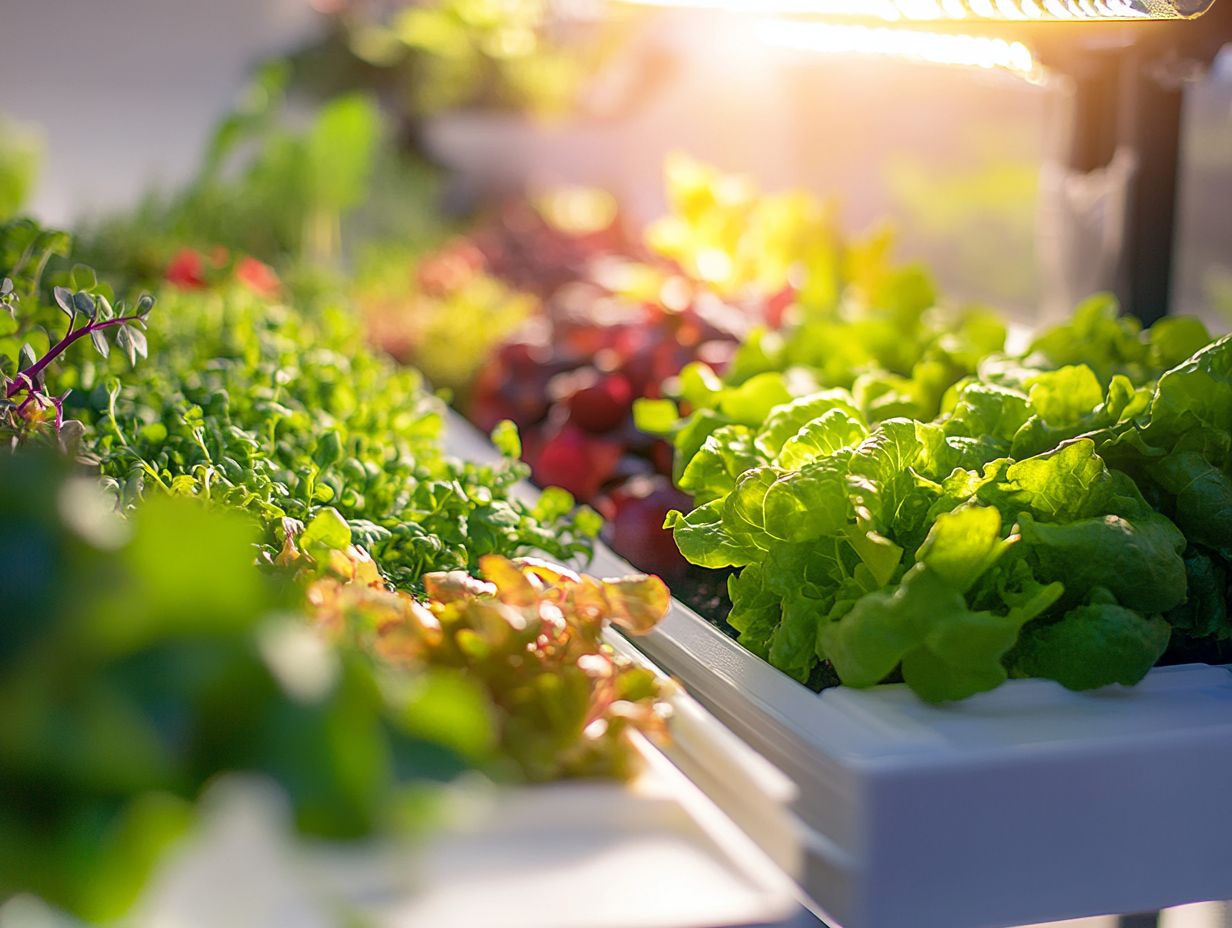
The future of DIY hydroponic gardening is bright, as more people are becoming interested in sustainable and efficient gardening methods. With advancements in technology and increased knowledge about hydroponics, it is predicted that this method of gardening will become even more popular in the future.
What are the benefits of DIY hydroponic gardening?
DIY hydroponic gardening has many benefits, such as using less water and space, producing higher yields, and the ability to grow plants year-round. It is also a more sustainable and eco-friendly way of gardening, as it does not require the use of pesticides or harmful chemicals.
Is DIY hydroponic gardening suitable for all types of plants?
Yes, DIY hydroponic gardening can be used to grow a wide variety of plants, from leafy greens and herbs to fruits and vegetables. However, certain plants may require specific nutrients and growing conditions, so it is important to do research and tailor your hydroponic setup accordingly.
Are there any downsides to DIY hydroponic gardening?
One potential downside to DIY hydroponic gardening is the initial cost of setting up the system. However, this can be offset by the savings in water and the potential for higher yields. It also requires a bit more knowledge and maintenance compared to traditional gardening methods.
Can hydroponic gardening help with food sustainability?
Yes, hydroponic gardening has the potential to greatly contribute to food sustainability. With the ability to grow food in smaller spaces and with less water, it can help address issues of food scarcity and reduce the strain on natural resources.
How can I get started with DIY hydroponic gardening?
To get started with DIY hydroponic gardening, you will need to research and gather materials for your chosen setup, such as containers, nutrient solutions, and lighting. It is also helpful to educate yourself on the basics of hydroponic gardening and seek guidance from experienced growers or online resources.
Start your hydroponic journey today and make a positive impact on your community!

